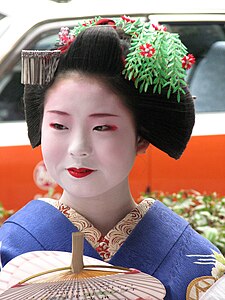
Quick Facts
Biography
A maiko (舞妓) is an apprentice geiko (not exactly same as geisha) in Kyoto, western Japan. Their jobs consist of performing songs, dances, and playing the shamisen or the koto (traditional Japanese instruments) for visitors during feasts. Maiko are usually aged 15 to 20 years old and become geiko after learning how to dance the traditional kyomai dances, play the shamisen, and learning Kyō-kotoba (dialect of Kyoto), regardless of their origins.
Origin
Maiko originated from women who served green tea and dango (Japanese dumpling made from rice flour) to people who visited the Kitano Tenman-gū or Yasaka Shrine (these are the two of the famous shrines in Kyoto) at teahouses in the temple town about 300 years ago.
At first, women served only green tea and dango, but they gradually started to perform songs and dances for visitors.
Appearance
Hair
During their career a maiko will wear different kinds of nihongami (Japanese traditional hairstyles) depending on rank, formality and occasion. They decorate their hairstyles with seasonal kanzashi (traditional hair ornaments). Maiko, unlike geiko, use their own hair and not wigs. They go to the nihongami hairdresser once a week, meaning that they have to sleep on a takamakura (wooden block with a pillow) in order to maintain it.
Wareshinobu
- (割れしのぶ): Wareshinobu is worn by junior maiko for the first 2-3 years. A mage (bun) is made by inserting two red kanako (padded silk) and is then decorated with a kanaokodome in the center of the mage. It's worn for misedashi (formal debut) where they will wear formal kanzashi made out of tortoise shell, silver and red miokuri and two bira bira.
Ofuku
- (おふく): Ofuku is the default hairstyle for senior maiko. It looks similar to wareshinobu, but the mage has a slightly different shape, and instead of stuffing the kanako inside the mage (bun), they will wear a tegara (triangle of silk) pinned to the outside. The color of the tegara changes as the maiko gets older. Right after switching hairstyles it will be red, then pink and finally blue. Sometimes colors such as green, yellow or orange are seen, although it is quite rare.
Yakko Shimada
- (奴島田): Yakko Shimada is worn by senior maiko for Shigyoshiki (the start of another year), Hassaku (summer Thanksgiving) and Setsubun. The mage is quite big and is parted with a hatsuyori kanzashi. For winter the hatsuyori will be mainly coral with one jade bead, and for summer it will be mainly jade with one coral bead. It also has a long kanako that can be many colors, although red most common.
Katsuyama
- (勝山): Katsuyama is worn by every senior maiko during Gion Matsuri. The mage resembles Yakko Shimada in both shape and in that it has a long kanako that can be red, pink or blue if the maiko is very senior. On either side of the mage are bon-ten (silver flower kanzashi). It is said that the hairstyle was created by the oiran Katsuyama from the Edo period. It used to be a popular hairstyle for married women.
Sakkou
- (先笄): Sakkou is the last hairstyle worn by maiko before becoming full fledged geiko, and is worn for two weeks before the erikae. It is the most elaborate and expensive of all the hairstyles. It's decorated with formal tortoise shell kanzashi, and a special sakkou kanzashi designed by the maiko herself, usually crest of the okiya and with auspicious animals like cranes and tortoises. The mage is very complex and has a hanging streak of hair. The night before the erikae the okaa-san (proprietress) and fellow maiko and geiko will cut the streak of hair and the ties holding the hairstyle together.
Hikizuri
- (引きずり): Maiko wear special kimono called hikizuri. They are usually 200 cm long, with a padded hem to create weight so it will trail beautifully on the floor. When outside a maiko will hold her hikizuri up with her hands, or tie it in place so that it does not touch the ground. The sleeves are long like a those of a furisode. The kimono can be any color and the motifs and patterns are seasonal. For formal occasions the maiko will wear a black hikizuri with 5 okiya crests.
Darari obi
- (だらり帯): The darari obi is a 6-7 meters long obi worn exclusively by maiko. Due to its length and weight an otokoshi-san (male dresser) is needed to tie it. At the end of the darari obi is a crest, so that every one can see which okiya the maiko belongs to. For formal occasions the maiko will wear a gold obi.

Two Kyoto maiko walking

Maiko wearing shidare kanzashi, composed by long chains of silk flowers

Maiko with willow kanzashi
| Maiko in Art |
|---|
Jobs
In the morning, maiko take lessons to polish their performances. At night, they go out to work. They are usually given the opportunity to eat at high-quality Japanese-style restaurants or stay in Japanese-style hotels. They perform dances, songs, play the shamisen, and serve visitors with sake. Recently, their jobs have expanded to include visiting nursing institutions or hospitals. Some maiko are also dispatched overseas.



